Back to the Brecks again today. It looked like it would be a glorious day, as it dawned bright & clear, with lovely blue skies. Great weather to be exploring the Brecks.
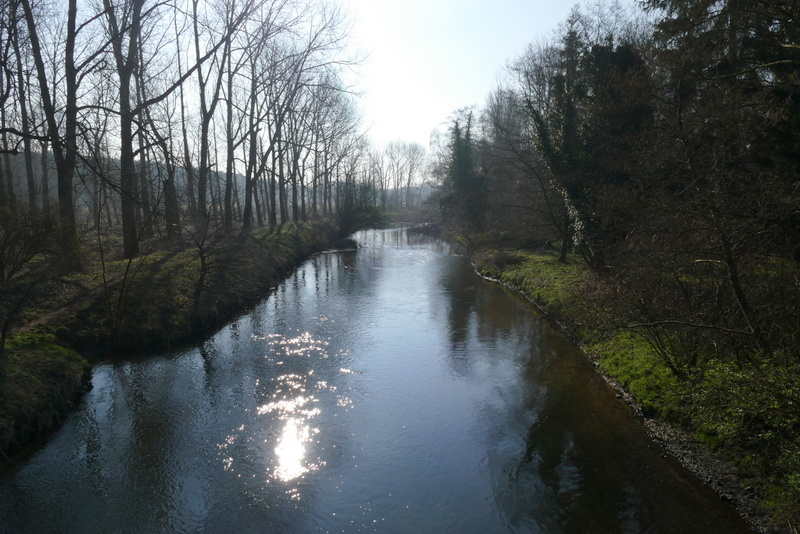 Santon Downham – the river in early morning sunshine
Santon Downham – the river in early morning sunshine
We started with a walk along the river at Santon Downham. From the bridge, we could see a pair of Grey Wagtails picking along the edge of a small patch of exposed stony mud down along the bank. As we walked down the steps, a Kingfisher called but we didn’t see it – presumably it had flown off the other way from under the bridge as we approached.
One of the local Starlings was singing outside a nest hole – with a very commendable impression of Lapwing thrown in to the mix. A Treecreeper was calling from high up in the poplars nearby. A pair of Siskins flew up from the edge of the ditch on the other side of the path and started feeding in the alder overhanging the river. We could hear several Siskins singing as we walked along, and saw more pairs zooming in and out through the treetops as they like to do at this time of year.
 Siskin – a pair were feeding in the trees beside the river
Siskin – a pair were feeding in the trees beside the river
As we walked down beside the river, we could hear Mandarin Ducks calling from the trees on the other side. They were obviously on the move, with the sound going back and forth behind the alders until they circled out of the trees and flew upstream along the river above us.
A Green Woodpecker was calling from the Suffolk side of the river as we walked out. Eventually it flew across to our side, landing briefly in the poplars before disappearing off back over the railway. There was a surprising lack of Great Spotted Woodpecker activity here today – there is normally no shortage of them here. Eventually one called and flew cross the river. Those were all the woodpeckers we managed here this morning, but we didn’t stay long. The air was now warming nicely and we had somewhere else we wanted to be this morning.
We drove on into the Forest and parked up by a suitable ride. The walk out through the commercial plantations was fairly quiet, apart from a few tits, especially Coal Tits, several of which were singing, and Goldcrests. A pair of Treecreepers were exploring the bark of a large old oak tree beside the path.
When we got to a small clearing, we could hear a Woodlark singing. A quick scan and we found it down on the ground on the path along the other side. It perched up on the fence briefly before flying down out of view, followed by a second Woodlark. We were just wondering whether to walk down to try to get a better look, when another Woodlark appeared in the top of a small fir tree much closer to us and started singing quietly. This one we got in the scope and had a much better look at.
 Woodlark – perched in the top of a fir tree, singing
Woodlark – perched in the top of a fir tree, singing
Further on, as we arrived in the main clearing, a dark male Pheasant, glossy bluish-purple and green, ran off into the trees. These so called ‘tenebrosus’ variant Pheasants are released in large numbers for shooting on some estates, which select different captive-bred forms based on their flight characteristics, but this is the first time we have seen one deep in the Forest.
We had not got much further, when we stopped to scan the trees and found two Common Buzzards circling up in the distance. Then one of the group spotted a different raptor circling nearby, very pale white below and silvery grey above as it caught the light, a Goshawk. It drifted over towards the Buzzards and started to circle with them, then as it climbed above them it had a couple of short stoops towards the Buzzards, pulling up just above them, as if warning them to be careful where they wandered!
After gaining a bit of height, the Goshawk started to glide away from them towards the other side of the clearing, where it clearly found another thermal as it started to gain height rapidly. It was very hard to keep track of against a clear blue sky, with no points of reference. It was getting closer but going much higher when we eventually lost sight of it high above us.
We walked round to the middle of the clearing, from where we could get a better all-round view. A Woodlark flew up from beside the path and circled round behind us, landing briefly on one of the fence posts nearby. There were several Woodlarks around here as usual, but they were rather slow to get going today. We could hear them calling and see the odd bird or pair flying back and forth, but it was comparatively late in the morning before they started to sing and songflight. Woodlarks are very early to return to their breeding sites in the spring and it is likely that some of them are already well established here. The Skylarks were rather more vocal in comparison.
We waited a while to see if the Goshawks would perform again. Despite the bright day and the warmth in the air, even the Common Buzzards were a little restrained today. There were several little groups of three or so we could see circling above the trees. Eventually, another Goshawk appeared over the trees, but it only circled up for a minute or so before folding its wings and dropping sharply back into cover. A Sparrowhawk circled up as well nearby, noticeably smaller and darker, with more rapid bursts of wingbeats and tighter circles as it spiralled up.
There were a lot of things we wanted to do today so, with our main target seen, we decided to move on. On the way back through the trees, one of the group saw a bird fly up from the ground along one of the side tracks. It perched on the branch of a pine tree over the path, half hidden amongst the needles, watching us and waiting for us to go past. It was a Grey Wagtail, a very odd bird to see in the middle of the Forest, more at home by the river as we had seen them earlier. It wanted to drop back down to the puddles in the ruts in the path, but was reluctant to do so while we were there. Presumably it was a migrant which had stopped off to feed here.
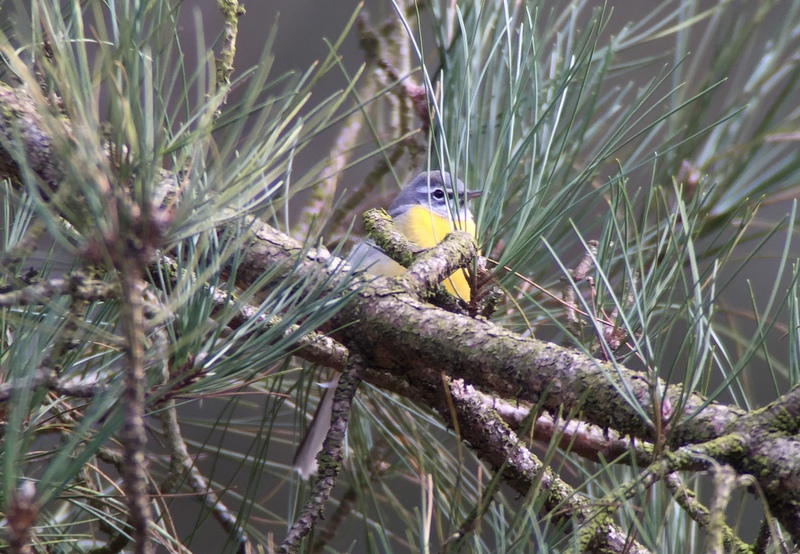 Grey Wagtail – surprised feeding by a puddle in the middle of the Forest
Grey Wagtail – surprised feeding by a puddle in the middle of the Forest
Our next stop was at Grimes Graves. The Great Grey Shrike was easy enough to find, in its usual clearing. Perched right on top of the bushes and small trees it really stood out, a bright white bird catching the sun. There was a surprising amount of heat haze here today and the Great Grey Shrike was a bit distant at first. We watched it repeatedly dropping down to the ground from its high perch, before flying up to the top of a different bush. Eventually it worked its way a little closer to us. There was a little bit of cloud in the sky now too, and when the sun went in the haze dropped sufficiently for us to get a better look at it.
 Great Grey Shrike – a recent photo of it here
Great Grey Shrike – a recent photo of it here
While we were watching the Great Grey Shrike, we heard the distinctive ‘glip, glip, glip’ calls of Crossbills. Unfortunately we couldn’t see them – and no sooner had we heard them than the sound disappeared over the trees behind us. Time was getting on now, so we headed off and round to Santon Downham for a late lunch.
After lunch, we walked up to the churchyard. As we were making our way up the road, we could hear Firecrest calling in the trees and then it broke into a quick burst of song, despite the fact that it was getting increasingly cloudy now. We cut in along a path and could see it flitting around. It perched in full view for a second, but it was hard for everyone to get onto it, before it disappeared further in. We followed it back out and onto the sunny edge by the road, but it had climbed back up into the tops of the trees now, where we could see it flicking in and out, occasionally doing little sallies into the air after small flies, but it was not ideal viewing. Then we heard the distinctive call of an F16 approaching and two jets came low overhead on their way towards USAF Lakenheath.
The Firecrest went quiet and disappeared into the trees for a minute or so, before we heard it singing again further up the road and back deeper in the trees. We chased after it and this time caught it feeding only about five metres up in the ivy round the trunk of a fir. Now we had great views of it, singing and calling but feeding all the time, picking at the leaves or making little flycatching flights, working its way up and down the tree. We could see its bright yellow crown stripe, its black and white-striped face which is the main distinguishing feature from the similar Goldcrest, as well as its brighter, cleaner white underparts and bronzey-gold patch on the sides of the neck. Firecrests are really stunning little birds!
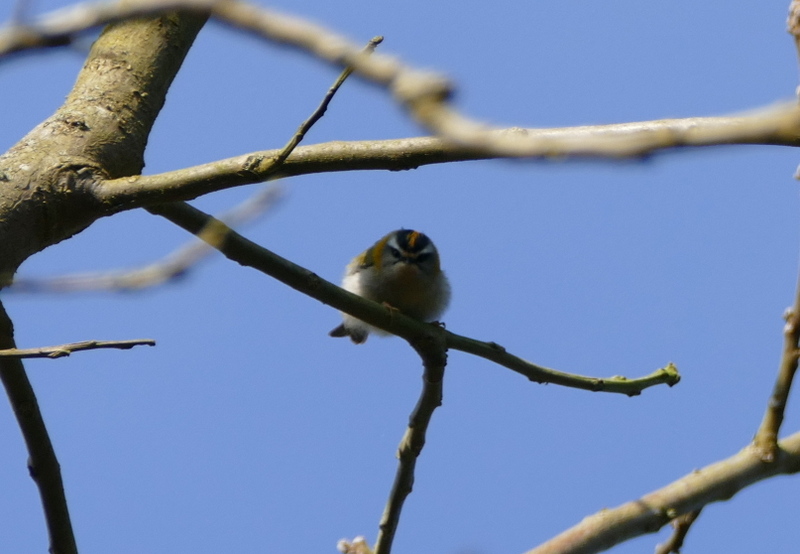 Firecrest – a photo from last year of one in the Brecks
Firecrest – a photo from last year of one in the Brecks
Our last stop of the day was at Lynford. We made our way down along the track and stopped briefly by the feeders. There was not much food out today, but a steady stream of Blue Tits, Great Tits and Coal Tits were attaching the fat balls, which are all but gone already. Amazing how quickly they have got through them! There were a few Chaffinches on the ground but still no real sign of the Hawfinches coming in here this year. We didn’t linger here long, but did stop a little further along to admire a smart male Bullfinch which was feeding on the buds of the bushes nearby. It perched in full view for a few seconds, but then retreated deeper into the vegetation when the cameras came out, where we could still just see it feeding amongst the branches and blossom.
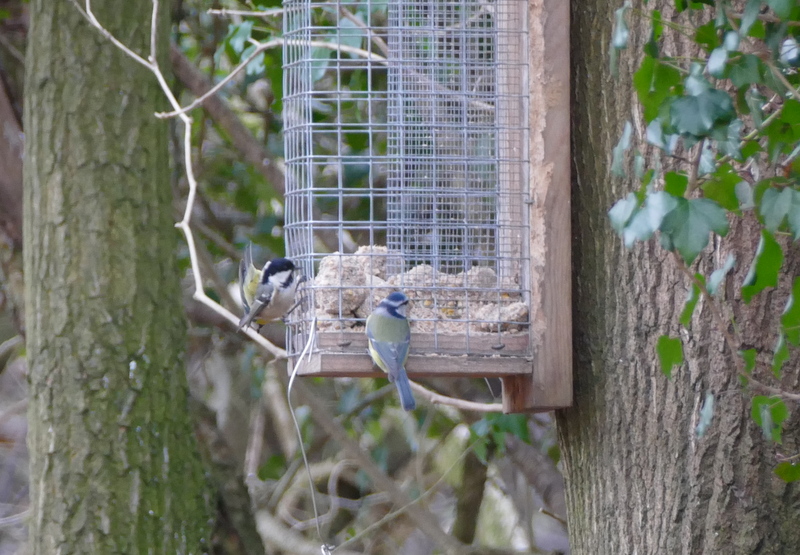 Blue Tits & Coal Tit – the fat balls are almost gone already!
Blue Tits & Coal Tit – the fat balls are almost gone already!
Down at the bridge, the food delivery for the day was just arriving – a selection of biscuit crumbs and seed mix was being liberally sprinkled about the posts and pillars. We carried straight on towards the paddocks and were surprised to see a line of cars beside the path. A tractor and trailer were nearby laden with fenceposts and we could see a gang of people working around the small overgrown wet grass area on the other side of the path from the paddocks. Needless to say, there was a huge amount of noise – knocking posts in, chainsawing the posts, then the tractor started up – we could barely hear ourselves think!
Above all the racket, we could just about hear a Hawfinch calling from the trees in the paddocks. We just managed to get it in the scope before it flew off towards the trees. We thought we could still hear another Hawfinch calling from the hornbeams, but it was impossible to work out where the sound was coming from with all the din behind us. There was a Hawfinch distantly in the trees behind, and we did get that one in the scope and get a better look at its huge nutcracker of a bill. It was slightly silhouetted against the light, so we decided to head round the other side where the light would be better, but there was no sign of it when we got there. We watched and waited for a while – we could hear Hawfinches calling at first and two flew across between the trees, but then it all went quiet. We decided to walk back to the side of the paddocks to see if they had gone back there to feed again.
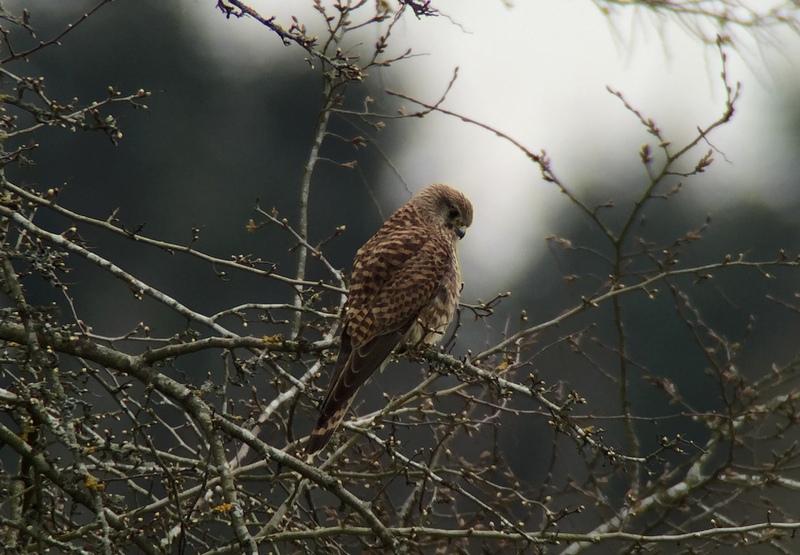 Kestrel – in the trees and on the wires round the paddocks as usual
Kestrel – in the trees and on the wires round the paddocks as usual
Even though it was now much quieter, as the working party had now abandoned the fence posts and gone, there was no sign of the Hawfinches back in the hornbeams. We waited a while to see if they might be feeding down below, but we could neither see nor hear them here. There were a few other birds around. The usual Kestrel was on the wires and in the trees. A smart Mistle Thrush perched up in the top of one of the hornbeams and a Song Thrush was singing nearby. Several Redwings also flew up from the grass and landed in the bushes. A pair of Jays flew in and one perched up nicely for us.
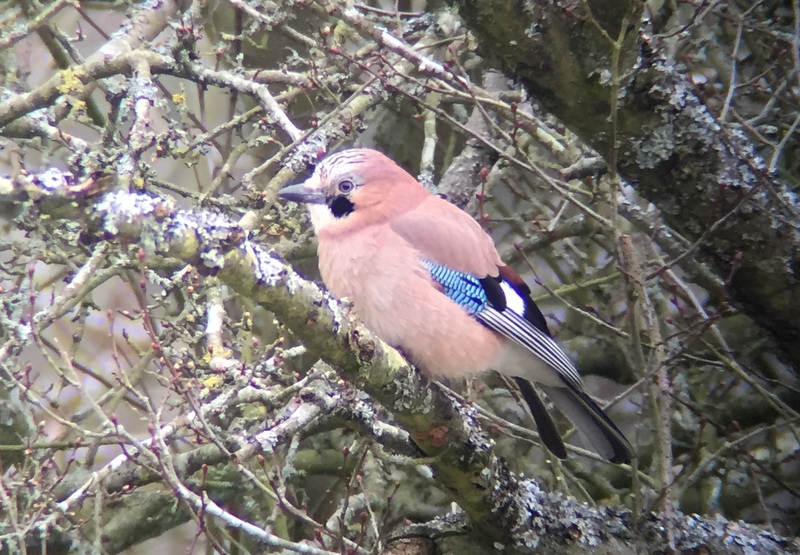 Jay – a pair flew in to the trees in the paddocks
Jay – a pair flew in to the trees in the paddocks
We decided to make our way back to the bridge, where a variety of birds were now coming in to enjoy the food put out for them. We had particularly nice views of a Marsh Tit which landed on the bridge close to us. The smart male Reed Bunting was back down on the food today – obviously the latest menu was more to its liking! We could hear the Little Grebes calling from the lake and see two of them diving for food out on the water. Then it was time to call it a day and head back.
















